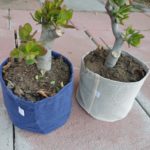
Introduction: Growing plants in containers, such as grow bags, is a popular method for gardening enthusiasts with limited space or poor soil conditions. However, there are often concerns about whether plants can be drowned in grow bags due to improper drainage. In this blog, we will explore the truth behind this common myth and provide you with a comprehensive understanding of how to effectively water your plants in grow bags.
Understanding Grow Bags: Before delving into the drowning myth, let's first understand what grow bags are. Grow bags are typically made of breathable fabric material that allows for excellent air circulation and prevents root circling, leading to healthier and more robust plants. Unlike traditional pots, grow bags offer better drainage and aeration, making them a popular choice among gardeners.
The Importance of Proper Drainage: One of the essential aspects of plant care, regardless of the container type, is ensuring proper drainage. Excess water around the roots can lead to oxygen deprivation, root rot, and ultimately the death of your plants. However, when it comes to grow bags, the risk of drowning your plants is significantly reduced due to their unique design.
Grow Bag Drainage Mechanism: Grow bags are specifically engineered to provide superior drainage. They typically have multiple drainage holes at the bottom and sometimes along the sides. These drainage holes allow excess water to escape, preventing waterlogging and providing oxygen to the roots.
Watering Techniques for Grow Bags: To ensure the health and vitality of your plants in grow bags, it's crucial to follow proper watering techniques. Here are some guidelines to keep in mind:
- Frequency: The frequency of watering depends on various factors such as plant type, weather conditions, and the size of the grow bag. Generally, it's better to water your plants deeply and less frequently rather than giving them small amounts of water frequently. This allows the roots to grow deeper and become more resilient.
- Water Quantity: When watering your plants in grow bags, it's important to avoid overwatering. Water the plants until you see water escaping through the drainage holes, ensuring that excess water doesn't accumulate in the grow bag.
- Watering Method: There are a few methods you can use to water your plants effectively. One common approach is to water the plants directly at the base, allowing the water to penetrate the soil and reach the roots. Another method is bottom watering, where you place the grow bag in a tray filled with water and allow the soil to absorb the moisture from below.
- Moisture Monitoring: Regularly check the moisture level of the soil by inserting your finger about an inch into the soil. If it feels dry, it's time to water your plants, but if it's still moist, hold off on watering for a little longer.
Conclusion: In conclusion, the notion that you can drown a plant in a grow bag is largely a myth. Grow bags are designed to provide superior drainage, making it difficult to overwater your plants as long as you follow proper watering techniques. Remember to monitor the moisture level of the soil, water deeply but less frequently, and ensure the excess water can drain out through the drainage holes.
By understanding the unique characteristics of grow bags and implementing appropriate watering methods, you can create a healthy and thriving environment for your plants. Happy gardening!

